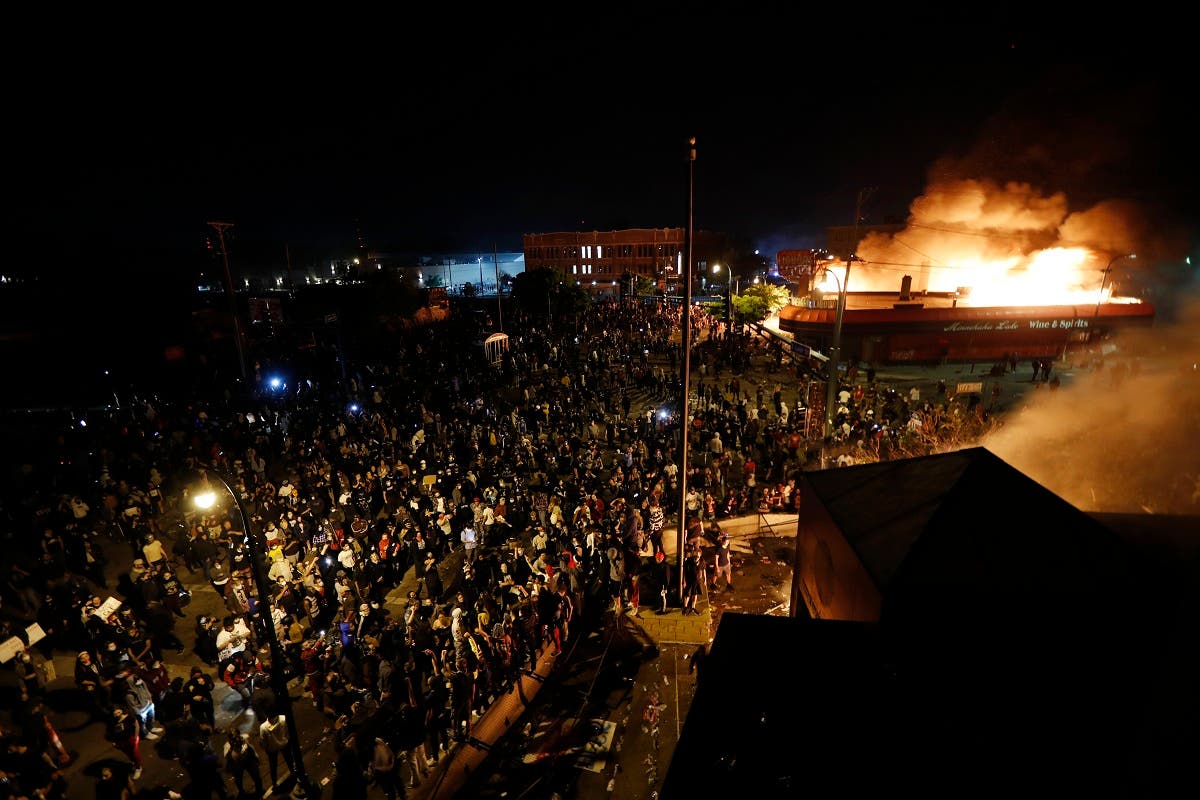Peaceful rallies gave way to a third night of arson, looting and vandalism in Minneapolis on Thursday as protesters vented their rage over the death of a black man seen on video gasping for breath while a white police officer knelt on his neck.
The latest spasm of unrest in Minnesota’s largest city went largely unchecked, despite Governor Tim Walz ordering the National Guard activated to help restore order following the first two days of disturbances sparked by Monday night’s fatal arrest of George Floyd, 46.
For all the latest headlines follow our Google News channel online or via the app.
In contrast with Wednesday night, when rock-throwing demonstrators clashed repeatedly with police in riot gear, law enforcement kept a low profile around the epicentre of the unrest, outside the city’s Third Precinct police station.
Protesters massing outside the building briefly retreated under volleys of police tear gas and rubber bullets fired at them from the roof, only to reassemble and eventually attack the building head-on, setting fire to the structure as police seemed to withdraw. Protesters were later observed on the roof.
A car and at least two other buildings in the vicinity were also set ablaze, and looters returned for a second night to a nearby Target discount store, left boarded up and vacant from the previous night, to make off with whatever remained inside.
Fire officials said 16 buildings were torched on Wednesday night.
There was no immediate sign of National Guard troops at the police station or at a peaceful daytime rally and march around the Hennepin County Government Center in downtown Minneapolis.
President Donald Trump on Twitter said that he will send the National Guard troops and “get the job done right” if Mayor Jacob Frey failed to bring the city under control.
“Any difficulty and we will assume control but, when the looting starts, the shooting starts,” he wrote in tweets posted late midnight.
Local, state and federal law enforcement officials sought earlier in the day to ease racial tensions sparked by Floyd’s death by vowing to achieve justice.
Four city police officers involved in the incident, including the one shown pressing his knee into Floyd’s neck as he lay on the ground, moaning, “please, I can’t breathe,” were fired from their jobs the next day.
The Floyd case was reminiscent of the 2014 killing of Eric Garner, an unarmed black man in New York City who died after being put in a banned police chokehold as he, too, was heard to mutter, “I can’t breathe.”
Garner’s dying words became a rallying cry for the Black Lives Matter movement that formed amid a wave of killings of African-Americans by police.
Throughout the day, protesters pressed their demands that the four policemen be arrested and prosecuted.
“There is probable cause right now” to make those arrests, civil rights activist the Rev. Al Sharpton said as he addressed the crowd. “We’re not asking for a favour. We’re asking for what is right.”
Garner’s mother, Gwen Carr, said Floyd’s case was like “opening up an old wound and pouring salt into it.”
‘Give us time to do this right’
At a morning news briefing, Police Chief Medaria Arradondo publicly apologized to Floyd’s family, conceding his department had contributed to a “deficit of hope” in Minneapolis.
Hours later, officials overseeing investigations from the US Justice Department, FBI, Minnesota Bureau of Criminal Apprehension and prosecutors appealed for calm at a joint news conference, as they gathered evidence.
“Give us the time to do this right, and we will bring you justice,” County Attorney Mike Freeman told reporters. He acknowledged the policeman’s conduct depicted in the video was “horrible,” but said, “My job is to prove that he has violated a criminal statute.”
Minnesota’s US attorney, Erica McDonald, pledged a “robust and meticulous investigation” of Floyd’s arrest and death.
The federal investigation, which Attorney General William Barr had designated a “top priority,” will focus on whether the arresting officers used the “colour of law” to deprive Floyd of his civil rights, she said.
Floyd, a Houston native known affectionately to friends as “Big Floyd” and who had worked as a nightclub security staffer, was suspected of trying to pass counterfeit money at a corner store when police took him into custody. An employee who called for help described the suspect as appearing to be drunk, according to a police transcript of the call.
Sympathy protests erupted on Wednesday in Los Angeles and Thursday in Denver, with hundreds of demonstrators blocking freeway traffic in both cities.
Thursday night’s unrest in Minneapolis reportedly spread into the adjacent city of St. Paul, the state capital.




